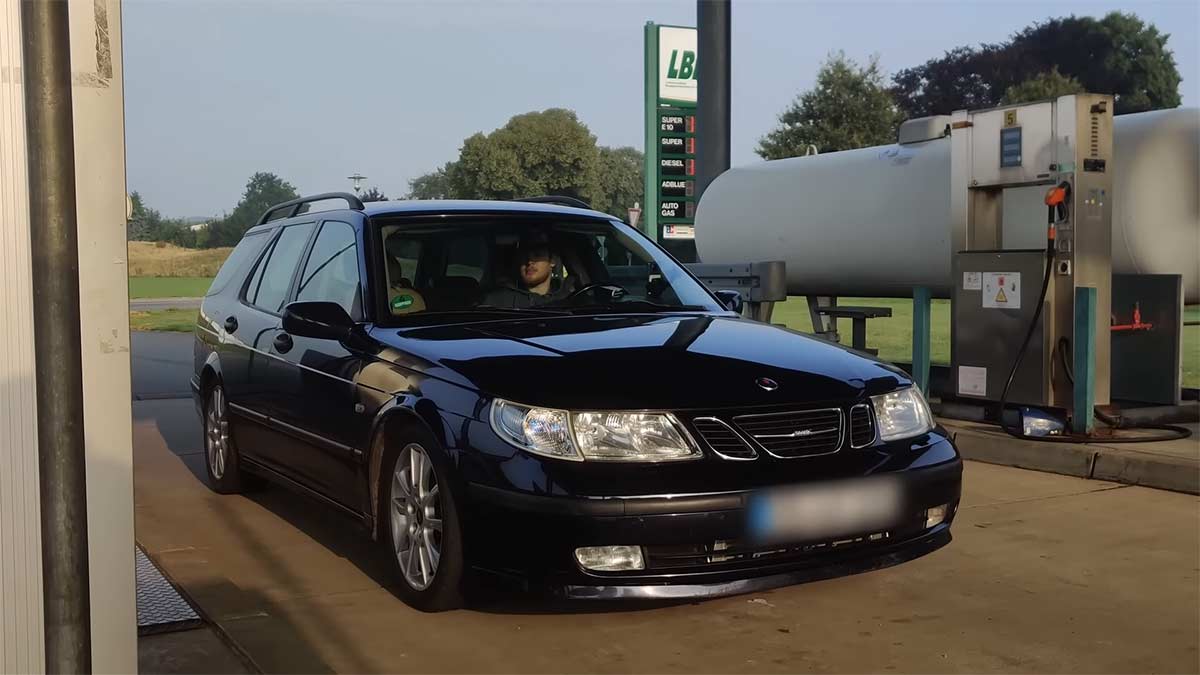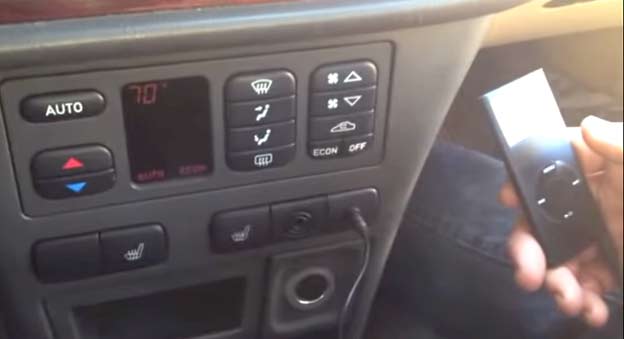The Unlikely Candidate: Saab 9-5 Aero SportCombi
Leon and Daniel, creators behind the DashcamDriversGermany project, are better known for documenting dashcam chaos on German roads. But this time, they decided to go full nerd mode and enter a different kind of test: a fuel economy challenge. Their weapon of choice?
A 2000s Saab 9-5 Aero SportCombi equipped with a 2.3L turbocharged inline-4 engine producing 250 horsepower. Hardly the car you’d expect in a hypermiling video.
With a full 70-liter tank and an emergency 5-liter canister sealed and untouched, they set off on a 17-hour drive across northern Germany, the Netherlands, and back—testing not just the car, but themselves.
Planning the Impossible: Setup and Strategy
Before hitting the road, they topped off the tank with E10 fuel—not the premium blends usually favored by fuel economy tests. The move was deliberate. As they stated, “everyone avoids E10, but we wanted to show that it can be efficient.”
They also employed a GPS-based tracking system, sealed the fuel cap with tamper-evident tape, and reset all onboard counters. Their route, stretching 1,212 km, was carefully plotted: from Fenne to the North Sea, through Bremen and Oldenburg, then into the Netherlands, finally looping back through Hamburg.
Key Strategy:
- Maintaining steady speeds around 80–90 km/h
- Drafting trucks with a 50-meter gap to reduce wind resistance
- Avoiding aggressive braking or acceleration
This wasn’t a theoretical lab test—it was a real-world, seat-of-the-pants challenge.
Real Conditions, Real Roads, Real Weather
One major difference between this test and traditional ones: they didn’t pick their weather.
Driving in real traffic meant:
- Tailwinds heading north helped reduce fuel use early on
- Urban congestion in the Netherlands caused delays and stop-and-go conditions
- Hot temperatures kept intake air temperatures around 27°C
Despite those variables, they maintained a consistent 5.7 L/100 km average fuel consumption—an outstanding number for a car weighing over 1,800 kg and pushing 250 horses.
Can a 250 HP Saab Really Sip Fuel?
Yes—and here’s how.
The Saab 9-5 Aero’s Trionic engine management system, which intelligently adjusts ignition timing and turbo boost, played a significant role. By maintaining engine load within a narrow efficiency band and taking full advantage of lean-burn cruising conditions, the 2.3L turbo behaved more like a diesel than a thirsty gasoline motor.
Even more surprising, they used E10 fuel—typically avoided for economy due to its lower energy content compared to Super Plus.
Technical Insights:
- ECU-adjusted ignition timing based on intake air temps
- Real-time fuel flow data from the onboard computer matched actual refill measurements
- Low rolling resistance tires at 3.1 bar pressure
This wasn’t luck. It was repeatable engineering backed by obsessive planning.
Busting the Myths: E10, Old Engines, and Performance
The video doubles as a myth-buster:
- Myth 1: Older turbocharged gasoline cars are fuel pigs.
— Busted. This test proved otherwise. - Myth 2: E10 is inferior for fuel economy.
— Busted. The onboard computer showed minimal knock correction and stable combustion. - Myth 3: You need premium fuel for maximum efficiency.
— Not necessarily. With proper tuning and mild load, E10 performs just fine.
As Leon explains, “The idea wasn’t to baby the car. It was to see what happens when you drive smart—not slow.”
The Final Numbers: What Did They Actually Achieve?
After 1,212.8 km and 69.05 liters of E10 burned, the final calculated result was:
Real-world fuel consumption: 5.69 L/100 km (41.3 MPG US)
With only 3 km of range remaining when they reached the original gas station 17 hours later, the test ended in full circle—literally and metaphorically.
The board computer’s estimate? Surprisingly accurate.
- Avg. speed: 80 km/h
- Total drive time: nearly 17 hours
- Refueled volume: 69.05 liters
Why It Matters for the Saab Community
This test is more than a curiosity. It’s a reminder of the untapped potential in Saab’s aging fleet. The Trionic 7 and Trionic 8 ECUs weren’t just early adopters of sophisticated engine control—they still hold their own in 2025.
For owners of Saab 9-5 Aero models, it sends a clear message: Your car is still competitive.
If driven with finesse, it can outperform expectations—on the road and at the pump.
Relevant reading:
Looking Ahead: DDG’s Take on Sustainable Driving
Leon and Daniel have plans to expand the scope of DashcamDriversGermany beyond dashcam antics. They’ve already teased upcoming content around “Realtalks” on road safety, traffic policy commentary, and sustainable driving practices.
This experiment fits perfectly into that future. It’s not just about fuel—it’s about awareness, rethinking how we drive, and proving that enthusiasm and mechanical sympathy still go hand in hand.
What’s Your Best Saab Fuel Economy Story?
There’s something inspiring about seeing a 20-year-old turbo Saab deliver fuel economy numbers that rival hybrids—without any gimmicks, tuning tricks, or lab conditions.
Now we turn it over to you: what’s the lowest fuel consumption you’ve ever achieved in your Saab?
Whether it was a cross-country trip, a mountain descent, or your own attempt at hypermiling—share your numbers and techniques in the comments.
Let’s see how far the Saab community has gone on a single tank, and what tricks you’ve learned behind the wheel.












My turbo se ng 93 saab 1999 achieved 1100 km from one tank various times on autobahn conditions
My Tid only gets 500/550 miles per tank, it says on the SID about 43mpg
I managed to achieve 1050kms on 98 octane gasoline with my manual 01′ Aero. I dont want to repeat.
Saab 9-5 2.0t model year 2007 automatic sedan. Last 88 368 km combined (highway, local ways, town, gravel and snow, +30 – -35 celsius) average consumption 11,89 l/100 km mostly with re85 fuel.
My lowest so far in a 2005 aero sedan.. allthough mine is an automatic is 6,7l/100km.. but i think thats because of the transmission… its now tuned.. so i think it should do better now than when it was stock
I have had several 9-5 and 9-3. Petrol/E85 and diesel. Manual and automatic. Linear, vector and aero. Always 4 cylinder engines (no V6). Different power outputs. I have never managed to get higher fuel consumption than 10,0 l/100 km (lowest: 3,2 l/100 km). Hmm…
2008 Aero wagon 2.3T, 93 octane, 75 mph =605 miles per tank on the highway= 33 mpg, no hyper milling. 120 kph, 973 km, so 14.3 km/l?
Every tankfull before a long highway run i’m saying “This time i’m gonna beat my milleage per tank!”, but then i don’t. She’s a temptress.
30Mpg tops, I had a mint one back in the day. 12Mpg if you had fun
Saab petrol werry good car. Dont make sence.
What engine
If you drive a long stretch and cruise in like 80 km/h it’s not impossible. I am usually at 8.9-9l/100km but then I go 110-120 and then thru roundabouts in town to work. It got a big gasoline tank… 1200 kilometers you really need to go slow, eco tires, high pressure in tires. Get it down to 7l/100 kilometers and it should go almost 1100 km… so on a good day with sun in the back, ac off and good tail wind…
My favorite 9-5. I had 2 Aeros, the break is so well designed. Never tired to drive…miles and miles at once…
yep, quality gasoline (not the ruSSian one) can do that with this car. I had similar Aero SportCombi 2004, and was no problem to run this 250 hp brick under 8l/100km in normal traffic condition. I also have the record for ca. 80km/h cruising with almost two ton V12 M70B50 with 9.3l / 100km for almost 300 km trip. In times we had ruSSian oil all was with 10-15% increase.
If I carefully drive my 93 with that Ecotec b207 4-pot, I can get 35 mpg. Yeah, not bad.
But that’s only after I deleted the center muffler and restrictor.
My Saab 9-3 cabriolet can only make around 35 miles per gallon on UK roads which are mostly poorly maintained, full of pot holes, speed restriction humps, traffic, road works at ever corner, in a nutshell mostly crap roads with over the top CCTV pervy cameras everywhere which I pay extortionate amounts on running costs to the greedy government plus almost £500 per year on road tax for the privilege.
Sounds right I did the same on a trip from Florida to New Jersey mine got to 41.2 miles per gallon – not bad for a 23 year old girl.